Dall’Hotel dove siamo alloggiati, sono cinque minuti a piedi, veniamo quindi a rendere omaggio alle vittime di questo disastro. All’epoca dei fatti la Chiesa di San Leonardo era in stato di abbandono e non era consacrata. Dopo la catastrofe venne ristrutturata e nuovamente consacrata.
From the hotel where we are staying, it is a five minute walk, so we come to pay homage to the victims of this disaster. At the time of the events the Church of San Leonardo was in a state of abandonment and was not consecrated. After the catastrophe it was renovated and consecrated again.
La chiesa di San Leonardo (dai locali chiamata “San Gianardo”) è ricordata nei documenti fin dal 1294. Secondo una tradizione, vi era annesso un Ospizio di Monaci benedettini camaldolesi (monaci bianchi) per la cura degli infermi e dei pellegrini. Tale Ospizio era collegato con analogo Ospizio in San Martino di Castrozza e da quello dipendeva. Ciò fino al 1418 quando, a quanto pare, gli Ordini monastici furono soppressi, su ordine imperiale, per qualche decennio.
The church of San Leonardo (called “San Gianardo” by the locals) is mentioned in documents since 1294. According to tradition, there was a hospice of Camaldolese Benedictine monks (white monks) attached to it for the care of the sick and pilgrims. This hospice was connected to a similar hospice in San Martino di Castrozza and depended on it. This was until 1418 when, apparently, the monastic orders were suppressed, on imperial orders, for a few decades.
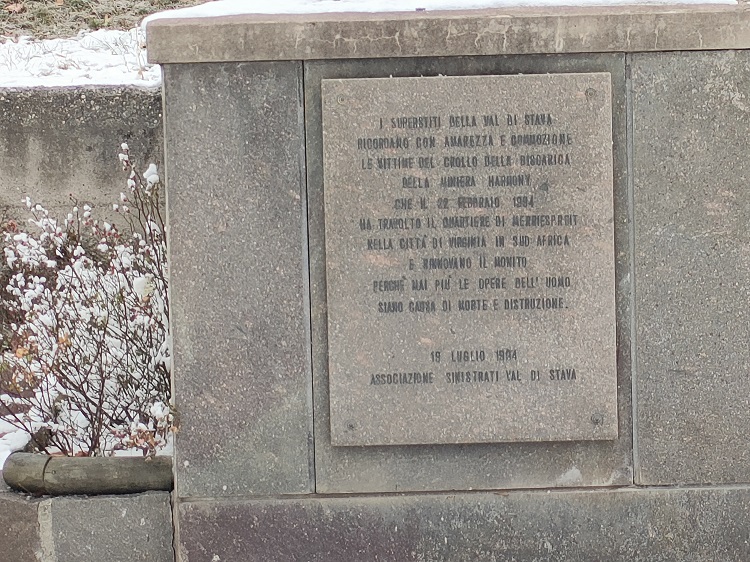
In questa chiesa pregò Papa Giovanni Paolo II venuto tra noi Pellegrino di cristiano conforto il 17 luglio 1988. Difatti, il Santo Padre, alle ore 16.40 di quel giorno, si trattenne per alcuni minuti in adorante preghiera davanti al Tabernacolo. Successivamente, dopo aver visitato e benedetto le tombe delle Vittime di Stava, si incontrò con i Familiari delle Vittime ai quali donò la sua meditazione carica di umanità e di sofferta condivisione nella luce però della Risurrezione di Cristo. Salito poi nella piana di Stava si incontrò con la numerosa folla ivi convenuta, alla quale rivolse un meditato pensiero denso di insegnamento e di sprone alla speranza e fortezza. Davvero: “il Signore ha visitato il Suo popolo!”
Pope John Paul II, who came among us as a pilgrim of Christian comfort on 17 July 1988, prayed in this church. In fact, the Holy Father, at 4.40 pm on that day, remained for a few minutes in adoring prayer in front of the Tabernacle. Subsequently, after having visited and blessed the tombs of the Victims of Stava, he met with the families of the Victims to whom he gave his meditation full of humanity and painful sharing in the light of the Resurrection of Christ. Having then ascended to the Stava plain, he met the large crowd gathered there, to whom he addressed a thoughtful thought full of teaching and encouragement to hope and fortitude. Truly: “the Lord has visited His people!”
Non passano inosservati, sulla parete esterna a sud il grande affresco di san Cistoforo e sopra il portale, incontriamo un’altro affresco (risalenti al Cinquecento) raffigurante il patrono San Leonardo accompagnato da Sant’Antonio Abate. Sullo sfondo il bel campanile con cuspide piramidale e trifore romaniche.
The large fresco of San Cistoforo does not go unnoticed, on the external south wall and above the portal, we encounter another fresco (dating back to the sixteenth century) depicting the patron saint San Leonardo accompanied by Sant’Antonio Abate. In the background the beautiful bell tower with a pyramidal spire and Romanesque three-light windows.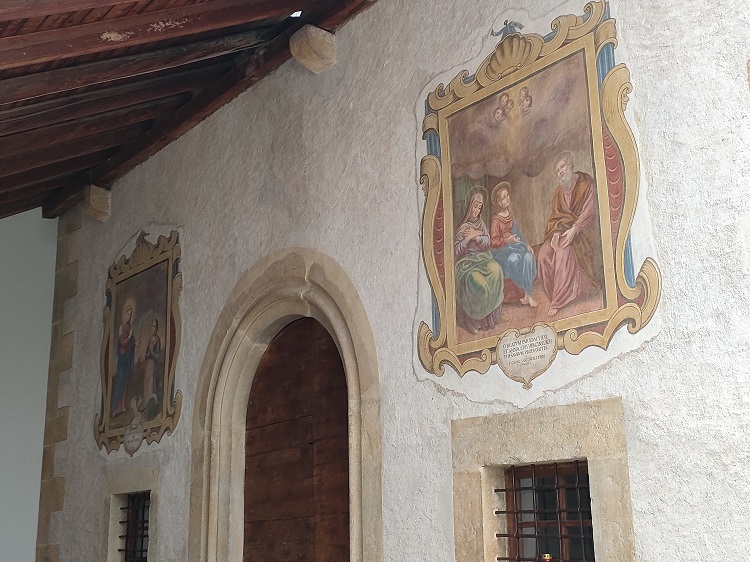
La grande tettoia che, secondo l’uso di Fiemme e Fassa, protegge il portone principale; ai lati del portone, gli affreschi dei “Santi Gioacchino e Anna” e “la Madonna di Caravaggio”.
The large roof which, according to the custom of Fiemme and Fassa, protects the main door; on the sides of the door, the frescoes of “Saints Joachim and Anna” and “the Madonna of Caravaggio”.
Sulle pareti della navata: a sinistra “l’Ultima Cena”.
On the walls of the nave: on the left “the Last Supper”.
A destra “Madonna con Bambino, Rocco e Giobbe” (datato 19.7.1541)
On the right “Madonna with Child, Rocco and Job” (dated 19.7.1541)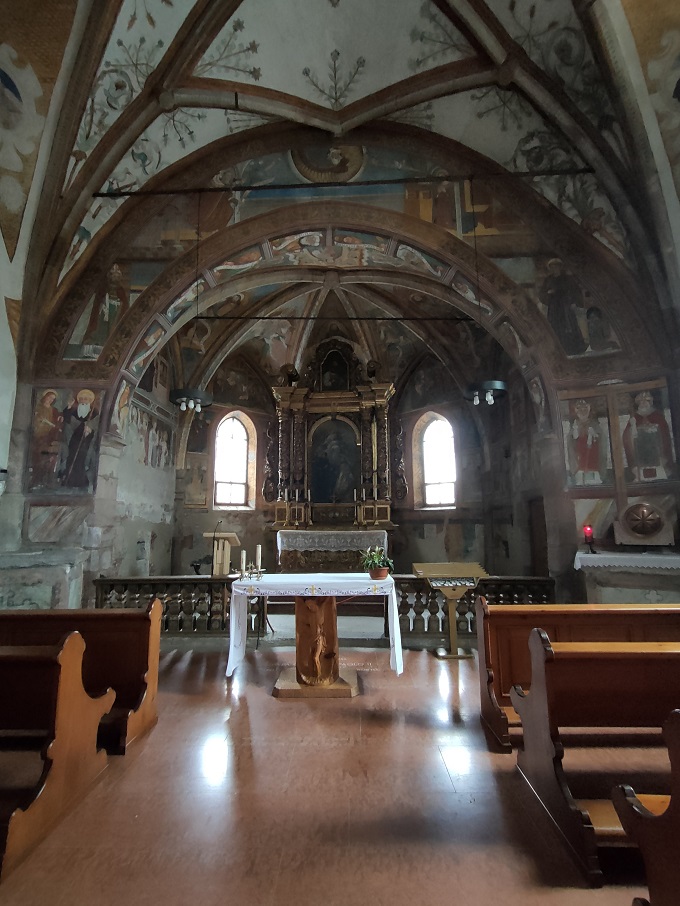
Sull’arcone: in alto: l’Annunciazione secondo una concezione popolaresca; all’interno dell’arcone: 10 profeti con apposto il nome. Rilevante l’affrescatura del presbiterio e della volta della navata, nonché la sapiente distribuzione dei vari temi dipinti, autentico “Liber pauperum” secondo il canone pittorico del tempo: nella volta della navata, tra i 37 spicchi decorati con grottesche e motivi floreali di delicata fattura, da rilevare i 12 medaglioni con Santi (Agata, Lucia, Elena, Leonardo, ecc.) e vari stemmi (Magnifica Comunità di Fiemme, Conti di Tirolo, Madruzzo, Gaudenzio, ovvero le autorità regnanti all’epoca sul territorio di Fiemme)
On the large arch: above: the Annunciation according to a popular conception; inside the arch: 10 prophets with their names affixed. The frescoes of the presbytery and the vault of the nave are notable, as well as the skilful distribution of the various painted themes, an authentic “Liber pauperum” according to the pictorial canon of the time: in the vault of the nave, among the 37 segments decorated with grotesques and delicate floral motifs invoice, to note the 12 medallions with Saints (Agata, Lucia, Elena, Leonardo, etc.) and various coats of arms (Magnificent Community of Fiemme, Counts of Tirolo, Madruzzo, Gaudenzio, i.e. the reigning authorities at the time in the territory of Fiemme)
Primo piano sulle raffigurazioni dei Santi Gottardo e Nicola nell’arcone a destra.
Close-up on the depictions of Saints Gotthard and Nicholas in the large arch on the right.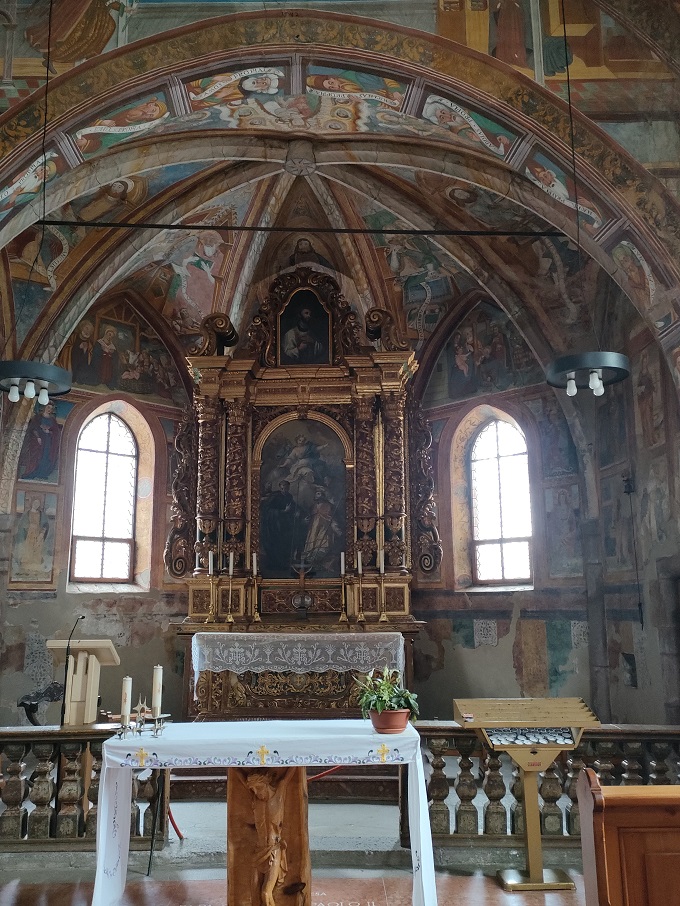
Nella volta absidale: divisa in sei spicchi, ecco: la Vergine con Bambino in gloria, i 4 Evangelisti con rispettivi simboli, i 4 Padri della Chiesa: Gregorio, Girolamo, Ambrogio, Agostino, Cristo benedicente, pantocràtore e 4 lunette con altrettanti episodi dell’infanzia di Gesù: la nascita, la presentazione al Tempio, l’adorazione dei Magi e la fuga in Egitto, dietro l’altare: la Crocifissione, datato 1542.
In the apse vault: divided into six segments, here is: the Virgin with Child in glory, the 4 Evangelists with their respective symbols, the 4 Fathers of the Church: Gregory, Jerome, Ambrose, Augustine, Christ blessing, pantocrator and 4 lunettes with as many episodes of the childhood of Jesus: the birth, the presentation in the Temple, the adoration of the Magi and the escape into Egypt, behind the altar: the Crucifixion, dated 1542.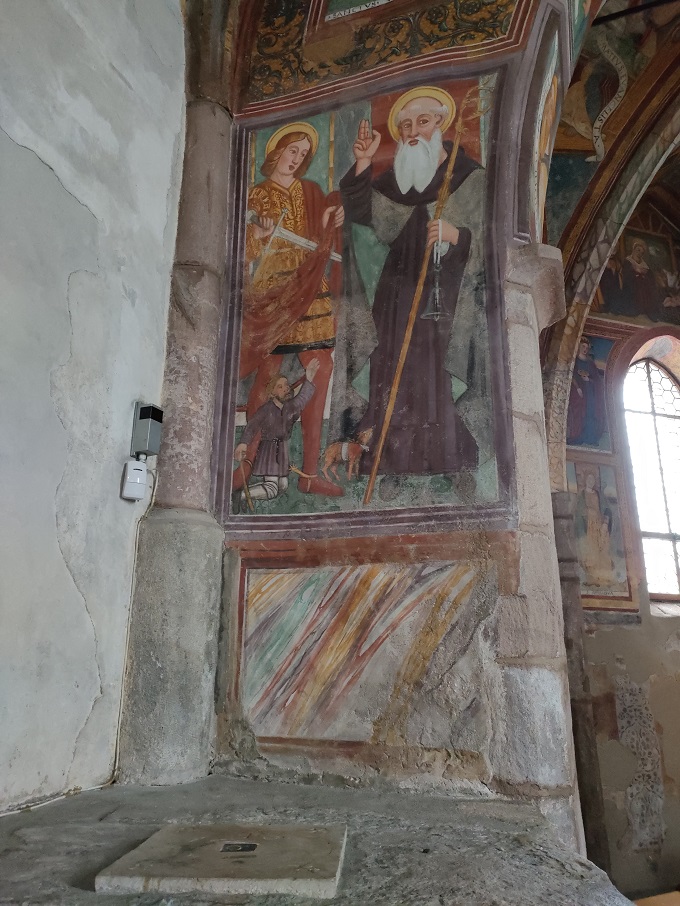
Primo piano sui Santi Santi Antonio e Martino raffigurati nell’arcone a sinistra.
Close-up on the Saints Anthony and Martin depicted in the arch on the left.
La “Pietà” (Antonio Longo, 1819)
The “Pietà” (Antonio Longo, 1819)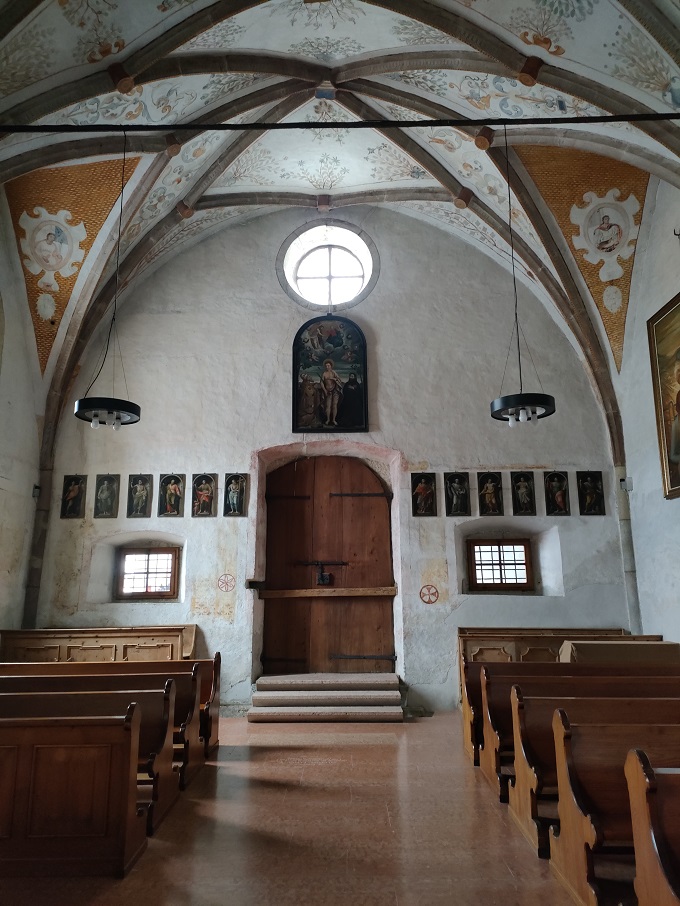
La serie dei “12 Apostoli” (Antonio Longo, 1815 circa)
The “12 Apostles” series (Antonio Longo, about 1815)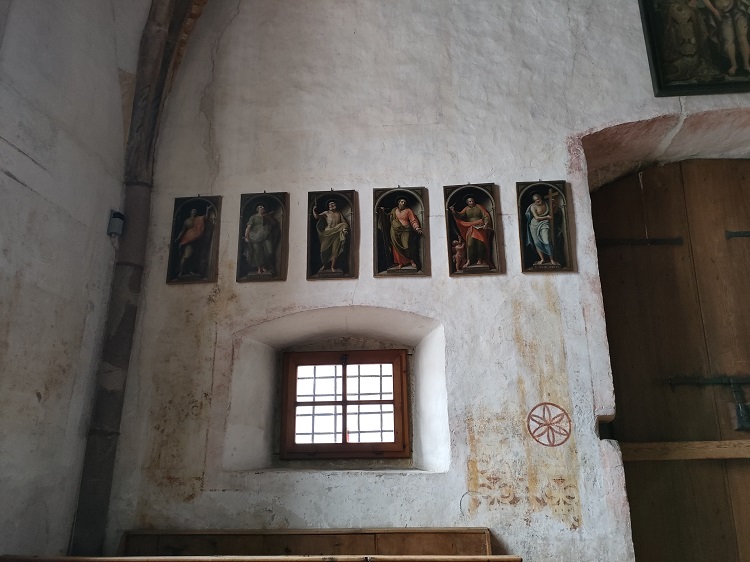
La chiesa, presumibilmente distrutta da un incendio (recenti scoperte lo confermano), fu ricostruita e ampliata nel 1440 e consacrata il 14 settembre 1474. Nei giorni funesti della tragedia di Stava (19 luglio 1985), la chiesa accolse tante salme di Vittime di tanto disastro, che poi trovarono decorosa commossa sepoltura nell’attiguo Cimitero.
The church, presumably destroyed by fire (recent discoveries confirm this), was rebuilt and enlarged in 1440 and consecrated on 14 September 1474. In the disastrous days of the Stava tragedy (19 July 1985), the church welcomed many bodies of victims of such a disaster, who then found a decorous and emotional burial in the adjacent cemetery.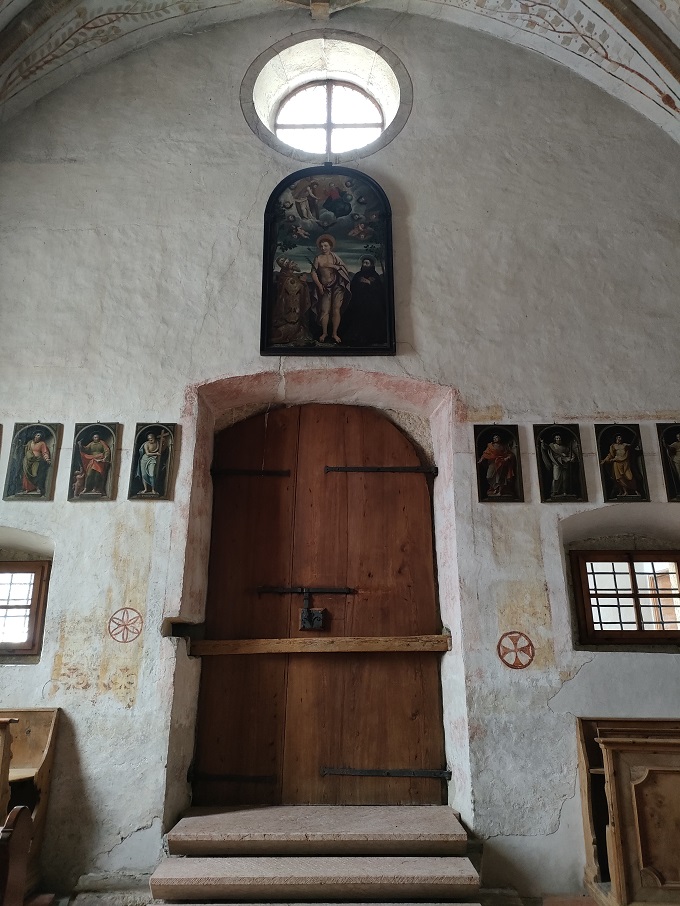
Centralmente, sopra il portone “I santi Sebastiano, Francesco e Fabiano con la Santissima Trinità” (autore ignoto, posteriore al 1612)
Centrally, above the door “Saints Sebastian, Francis and Fabiano with the Holy Trinity” (author unknown, after 1612)
In tempi recenti, anni 1983 e 1987/88, ad opera di solerte Comitato e dell’allora parroco don Giovanni Conci, con l’aiuto di Enti e di privati ed il contributo della Provincia Autonoma di Trento, la chiesa fu completamente restaurata con notevoli lavori di miglioria e così, restituita al culto pubblico.
In recent times, the years 1983 and 1987/88, by the diligent Committee and the then parish priest Don Giovanni Conci, with the help of organizations and private individuals and the contribution of the Autonomous Province of Trento, the church was completely restored with considerable improvement works and thus, returned to public worship.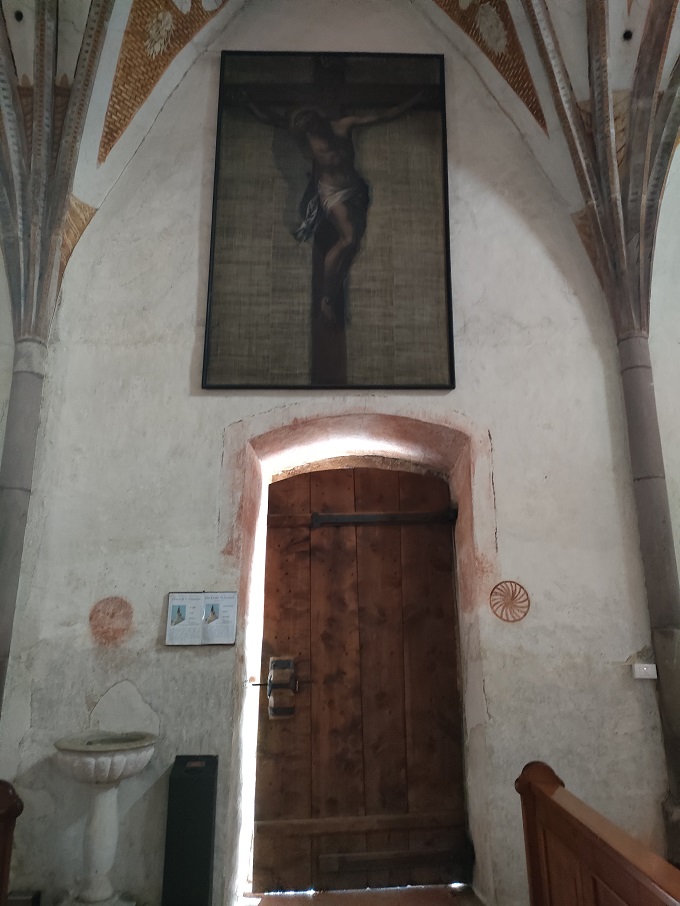
Il Crocifisso (autore ignoto – sec. XIX)
The Crucifix (unknown author – 19th century)
Il quadro del pittore di Soraga di Fassa Renato Decrestina porta il titolo emblematico “Stava 19.7.1985”. Presentato il 20 settembre del 1987 alla chiesetta dell’Addolorata di Stava e qui conservato per alcuni anni è ora esposto, dopo restauro in seguito ad un danneggiamento, presso la chiesa di San Leonardo, sulla parete nordorientale, di fronte al portoncino d’ingresso. La chiara ispirazione alla “Deposizione del Cristo”, con la presenza delle pie donne Maria Maddalena, Maria madre di Giacomo e Salome, è però accompagnata a due elementi essenziali di caratterizzazione: la mancanza della croce, di Giuseppe d’Arimatea, di Nicodemo, che nell’iconografia classica hanno materialmente eseguito il lavoro di schiodare il corpo di Gesù dalla croce e soprattutto il paesaggio che non riproduce il Calvario evangelico. Sfondo per le figure in primo piano è infatti la valle di Stava, distrutta e coperta di fango così come si presentava il 19 luglio 1985. Riconoscibili sono infatti la ringhiera del ponte sul rio Stava, così com’era allora, e il campanile della chiesa di San Leonardo sulla destra. Sul quadro sono riportate le parole dell’autore “Piango la tua infausta morte, oh Stava gentile, là dove l’incauto e folle progresso dell’uomo ti chiuse gli occhi. Ti chiamo sgomento, oh Stava sommersa, che l’acre ruine di fanghiglia contorta – ingrata – la vita ti tolse!”
The painting by the painter from Soraga di Fassa Renato Decrestina bears the emblematic title “Stava 19.7.1985”. Presented on 20 September 1987 at the small church of Addolorata in Stava and kept here for a few years, it is now exhibited, after restoration following damage, at the church of San Leonardo, on the north-eastern wall, in front of the entrance door. The clear inspiration from the “Deposition of Christ”, with the presence of the pious women Mary Magdalene, Mary mother of James and Salome, is however accompanied by two essential elements of characterization: the lack of the cross, of Joseph of Arimathea, of Nicodemus, who in classical iconography physically carried out the work of removing the body of Jesus from the cross and above all the landscape which does not reproduce the evangelical Calvary. The background for the figures in the foreground is in fact the Stava valley, destroyed and covered in mud as it appeared on 19 July 1985. Recognizable are in fact the railing of the bridge over the Stava stream, as it was then, and the bell tower of the church of San Leonardo on the right. The author’s words are shown on the painting: “I mourn your unfortunate death, oh gentle one, there where the reckless and crazy progress of man closed your eyes. I call you dismayed, oh Submerged Sea, which the acrid ruin of twisted – ungrateful – mud took your life away!”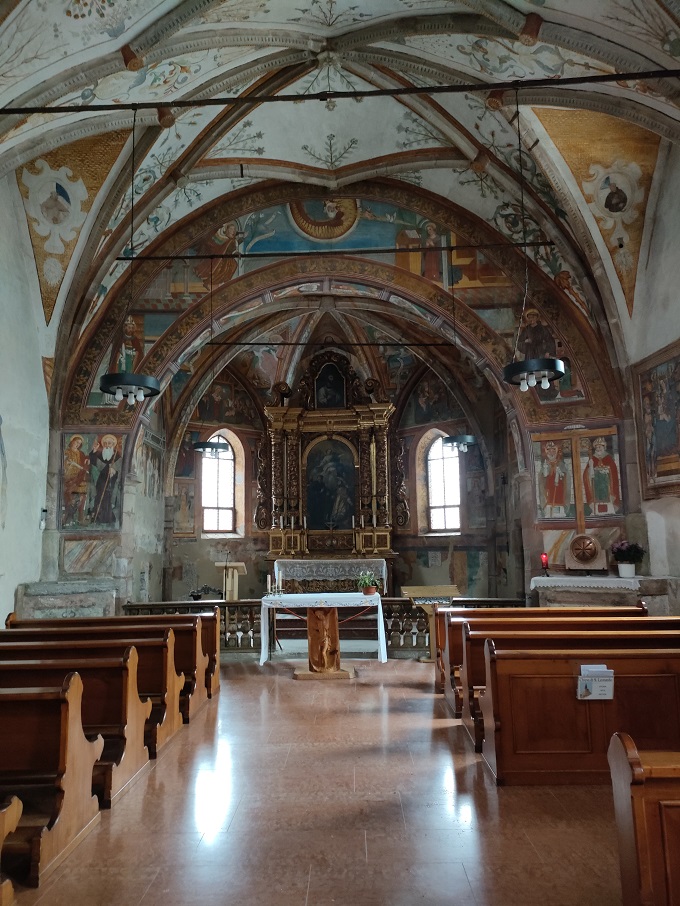
La Pala dell’altare “l’Immacolata con i santi Leonardo, Carlo Borromeo, Valerio, Pietro d’Alcàntara” (Francesco Unterberger, ca. 1740). L’altare ligneo, abbondantemente intagliato e decorato (autore ignoto, sec. XVIII).
The altarpiece “the Immaculate with the saints Leonardo, Carlo Borromeo, Valerio, Pietro d’Alcàntara” (Francesco Unterberger, ca. 1740). The wooden altar, abundantly carved and decorated (unknown author, 18th century).
La chiesa di San Leonardo sorge lungo la strada di collegamento tra Tesero e Stava con orientamento a est. Eretto probabilmente tra la fine del XIV e l’inizio del XV secolo, l’edificio subì un intervento di ampliamento e totale riqualificazione in forme gotiche durante la prima metà del XVI secolo.
The church of San Leonardo stands along the road connecting Tesero and Stava, facing east. Probably built between the end of the 14th and the beginning of the 15th century, the building underwent an expansion and total redevelopment in Gothic forms during the first half of the 16th century.
Ogni chiesa porta con sè “attraverso il trascorrere dei tempi ed il susseguirsi delle vicende umane” tanti ricordi e testimonianze. Qualcuno di questi ricordi può risultare poco documentabile per la critica storica, ma ciò non toglie che sia comunque caro alla tradizione popolare, come ad esempio la storia dei “monaci bianchi” che per qualche secolo, pare, furono pionieri di accoglienza e di assistenza quando le contrade erano tutt’altro che di facile percorrenza.
Every church brings with it “through the passage of time and the succession of human events” many memories and testimonies. Some of these memories may be difficult to document for historical criticism, but this does not mean that they are still dear to popular tradition, such as the story of the “white monks” who for a few centuries, it seems, were pioneers of hospitality and assistance when the districts were anything but easy to navigate.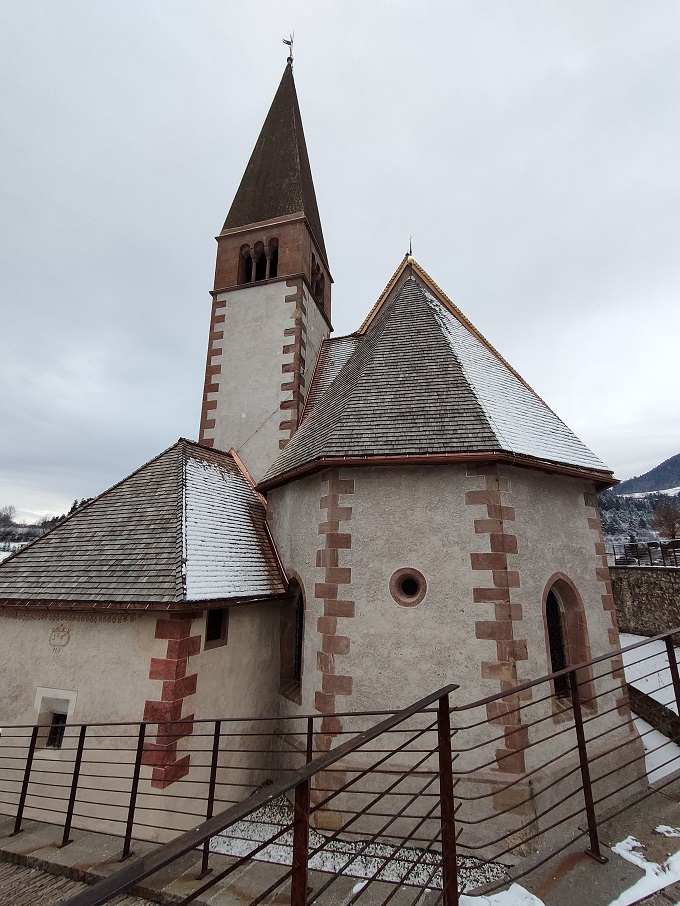
Ora, la bella chiesa, sembra vegliare e custodire i Morti che via-via sono aumentati nel cimitero e invita familiari ed amici a sostare in quieto raccoglimento nel luogo sacro per chiedere a Gesù Eucaristico speranza e fortezza per ben proseguire nel cammino della vita, verso la Casa del Padre.
Now, the beautiful church seems to watch over and guard the Dead who have gradually increased in the cemetery and invites family and friends to stop in quiet contemplation in the sacred place to ask Eucharistic Jesus for hope and fortitude to continue on the path of life, towards the House of the Father.
Fausto Forni © Tutti i diritti riservati.

